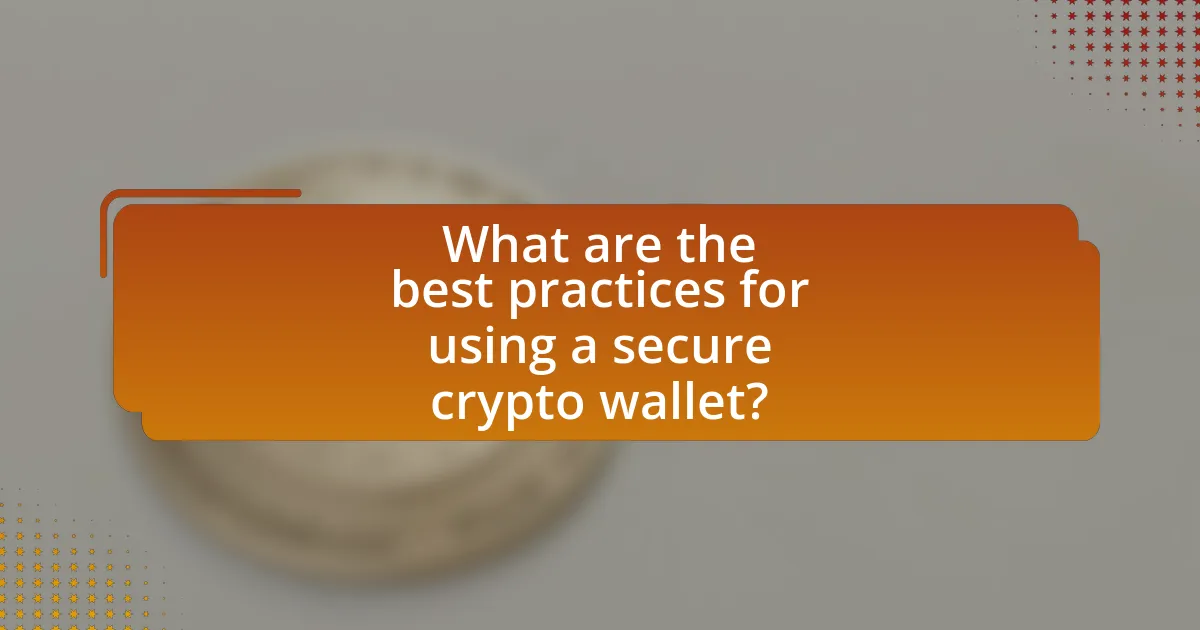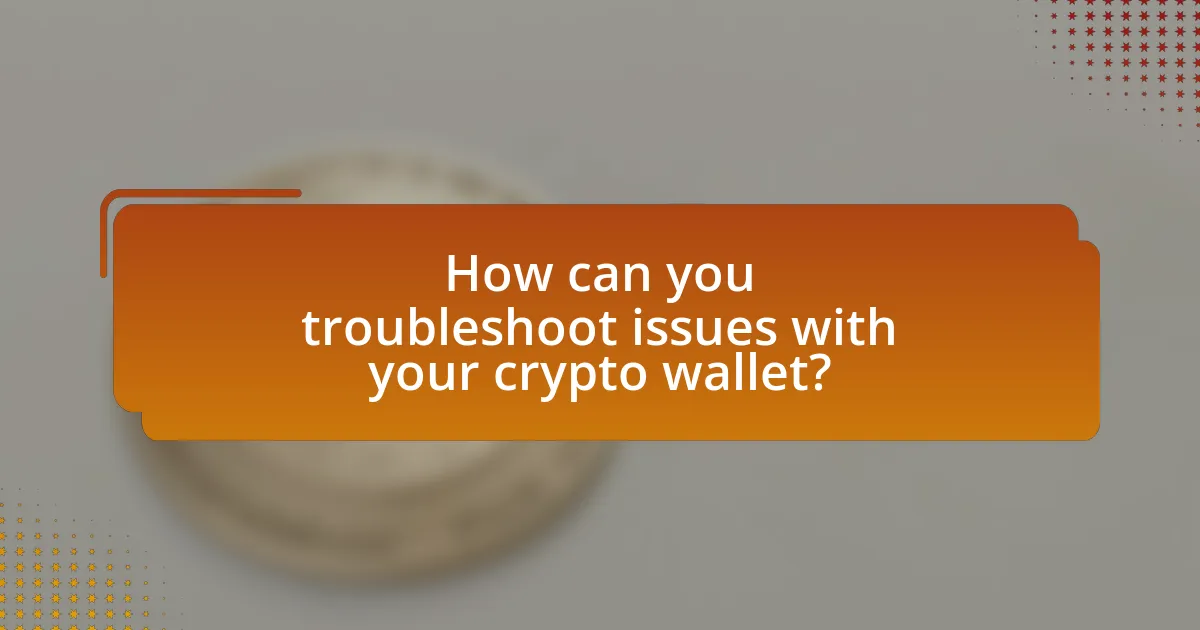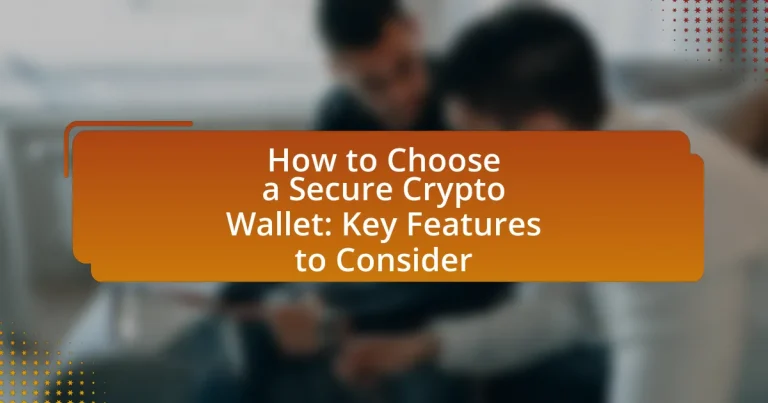A secure crypto wallet is a digital tool designed to safely store cryptocurrencies using advanced encryption and security protocols. This article outlines the key features to consider when choosing a secure crypto wallet, including the differences between secure and regular wallets, types of secure wallets, and essential security measures such as encryption and two-factor authentication. It also addresses common risks associated with crypto wallets, best practices for maintaining security, and troubleshooting steps for potential issues. By understanding these aspects, users can make informed decisions to protect their digital assets effectively.

What is a Secure Crypto Wallet?
A secure crypto wallet is a digital tool that safely stores cryptocurrencies by using advanced encryption techniques and security protocols. These wallets protect private keys, which are essential for accessing and managing digital assets, from unauthorized access and theft. For instance, hardware wallets, which are physical devices, provide a high level of security by keeping private keys offline, making them less vulnerable to hacking. Additionally, secure wallets often incorporate features such as two-factor authentication and multi-signature support, further enhancing their security measures.
How do secure crypto wallets differ from regular wallets?
Secure crypto wallets differ from regular wallets primarily in their enhanced security features designed to protect digital assets. Secure wallets, such as hardware wallets, store private keys offline, making them less vulnerable to hacking and malware attacks, while regular wallets, often software-based, may store keys online, exposing them to greater risks. For instance, hardware wallets like Ledger and Trezor utilize encryption and require physical access to authorize transactions, significantly reducing the likelihood of unauthorized access. In contrast, regular wallets may lack such robust security measures, making them more susceptible to breaches.
What types of secure crypto wallets are available?
There are three main types of secure crypto wallets: hardware wallets, software wallets, and paper wallets. Hardware wallets, such as Ledger and Trezor, store private keys offline, providing strong security against online threats. Software wallets, which can be desktop or mobile applications, offer convenience but are more vulnerable to malware and hacking. Paper wallets involve printing the private keys on paper, ensuring they are completely offline, but they require careful handling to avoid physical damage or loss. Each type has its own security features and risks, making it essential for users to choose based on their specific needs and threat models.
Why is security crucial for crypto wallets?
Security is crucial for crypto wallets because they store private keys that grant access to digital assets. Without robust security measures, these wallets are vulnerable to hacking, theft, and unauthorized access, which can lead to significant financial losses. For instance, in 2021, over $3 billion was stolen from various cryptocurrency exchanges and wallets due to security breaches, highlighting the importance of implementing strong security protocols. Therefore, ensuring the security of crypto wallets is essential to protect users’ investments and maintain trust in the cryptocurrency ecosystem.
What are the key features of a secure crypto wallet?
A secure crypto wallet must include features such as strong encryption, two-factor authentication (2FA), and backup recovery options. Strong encryption protects private keys and transaction data from unauthorized access, ensuring that only the wallet owner can access their funds. Two-factor authentication adds an additional layer of security by requiring a second form of verification, such as a code sent to a mobile device, before allowing access to the wallet. Backup recovery options enable users to restore their wallet in case of device loss or failure, safeguarding their assets. These features collectively enhance the security of a crypto wallet, making it resilient against hacking and theft.
How does encryption enhance wallet security?
Encryption enhances wallet security by converting sensitive data into a coded format that can only be accessed with a specific key or password. This process protects the wallet from unauthorized access, ensuring that even if a hacker intercepts the data, they cannot read it without the decryption key. For instance, strong encryption algorithms like AES (Advanced Encryption Standard) are widely used in secure wallets, providing a robust layer of security that is difficult to breach. According to a study by the National Institute of Standards and Technology, encryption significantly reduces the risk of data breaches, making it a critical feature for any secure crypto wallet.
What role does two-factor authentication play?
Two-factor authentication (2FA) enhances security by requiring two forms of verification before granting access to an account. This additional layer significantly reduces the risk of unauthorized access, as it necessitates not only a password but also a second factor, such as a code sent to a mobile device. According to a study by Google, implementing 2FA can block 99.9% of automated attacks, demonstrating its effectiveness in protecting sensitive information, particularly in the context of securing crypto wallets.
What are the common risks associated with crypto wallets?
Common risks associated with crypto wallets include hacking, loss of private keys, phishing attacks, and software vulnerabilities. Hacking occurs when cybercriminals exploit weaknesses in wallet security, leading to unauthorized access and theft of funds. Loss of private keys can result in permanent loss of access to the cryptocurrency, as these keys are essential for transaction authorization. Phishing attacks trick users into revealing sensitive information, often through fake websites or emails, compromising wallet security. Software vulnerabilities can arise from bugs or outdated software, making wallets susceptible to exploitation. According to a report by Chainalysis, over $3.2 billion was stolen from crypto wallets in 2020 alone, highlighting the significant risks involved.
How can users protect themselves from hacking?
Users can protect themselves from hacking by implementing strong, unique passwords and enabling two-factor authentication (2FA) on their accounts. Strong passwords should consist of at least 12 characters, including a mix of uppercase letters, lowercase letters, numbers, and special symbols, which significantly reduces the likelihood of unauthorized access. According to a study by the National Institute of Standards and Technology, using 2FA can block 99.9% of automated attacks, making it a crucial step in enhancing security. Additionally, users should regularly update their software and be cautious of phishing attempts, as these practices further safeguard against potential hacking threats.
What are the implications of losing access to a wallet?
Losing access to a wallet results in the permanent loss of any cryptocurrencies stored within it. This is because most wallets, especially non-custodial ones, do not have recovery options or customer support to retrieve lost funds. For instance, if a user loses their private keys or recovery phrases, they cannot access their assets, which can lead to significant financial loss. According to a study by Chainalysis, approximately 20% of all Bitcoin is considered lost due to inaccessible wallets, highlighting the critical implications of losing access.
How can you evaluate the security of a crypto wallet?
To evaluate the security of a crypto wallet, assess its features such as private key management, encryption standards, and multi-factor authentication. A wallet that allows users to control their private keys offers greater security, as it reduces reliance on third-party services. Additionally, wallets employing strong encryption protocols, like AES-256, protect user data from unauthorized access. Multi-factor authentication adds another layer of security by requiring multiple forms of verification before granting access. According to a report by the Blockchain Security Alliance, wallets with these features significantly reduce the risk of hacks and unauthorized transactions, making them more secure options for storing cryptocurrencies.
What should you consider when choosing a crypto wallet?
When choosing a crypto wallet, you should consider security features, usability, and compatibility with various cryptocurrencies. Security features include two-factor authentication, private key control, and encryption methods, which protect your assets from unauthorized access. Usability refers to the wallet’s interface and ease of use, ensuring that both beginners and experienced users can navigate it effectively. Compatibility is important as it determines whether the wallet supports the specific cryptocurrencies you intend to store or trade. For instance, hardware wallets like Ledger and Trezor are known for their high security, while software wallets like Exodus offer user-friendly interfaces.
How important is the wallet’s reputation and reviews?
The wallet’s reputation and reviews are critically important when selecting a secure crypto wallet. A strong reputation indicates reliability and trustworthiness, while positive reviews often reflect user satisfaction and security performance. For instance, wallets with high ratings on platforms like Trustpilot or CoinMarketCap typically demonstrate a history of secure transactions and effective customer support, which are essential for safeguarding assets. Additionally, a wallet’s reputation can be assessed through its track record in handling security breaches; wallets with a history of minimal incidents are generally more trustworthy. Therefore, evaluating a wallet’s reputation and reviews is essential for ensuring the safety of cryptocurrency holdings.
What features should you prioritize based on your needs?
Prioritize security features such as two-factor authentication, private key control, and multi-signature support based on your needs for a secure crypto wallet. Two-factor authentication adds an extra layer of protection by requiring a second form of verification, which significantly reduces the risk of unauthorized access. Private key control ensures that you have sole ownership of your keys, preventing third-party access to your funds. Multi-signature support enhances security by requiring multiple signatures for transactions, making it harder for a single compromised key to result in a loss of assets. These features collectively contribute to a robust security framework essential for safeguarding cryptocurrency holdings.

What are the best practices for using a secure crypto wallet?
The best practices for using a secure crypto wallet include enabling two-factor authentication, regularly updating wallet software, using strong, unique passwords, and keeping private keys offline. Two-factor authentication adds an extra layer of security, significantly reducing the risk of unauthorized access. Regular software updates ensure that the wallet is protected against the latest vulnerabilities, as cyber threats evolve rapidly. Strong, unique passwords prevent easy guessing or brute-force attacks, while storing private keys offline, such as in a hardware wallet, minimizes exposure to online threats. These practices are supported by cybersecurity studies indicating that multi-layered security approaches effectively mitigate risks associated with digital asset management.
How can you ensure your wallet remains secure over time?
To ensure your wallet remains secure over time, regularly update your wallet software and use strong, unique passwords. Keeping your wallet software updated protects against vulnerabilities that could be exploited by hackers, as outdated software is often a target for attacks. Additionally, using strong, unique passwords minimizes the risk of unauthorized access; studies show that 81% of data breaches are due to weak or reused passwords. Implementing two-factor authentication further enhances security by adding an extra layer of protection.
What regular maintenance should you perform on your wallet?
Regular maintenance for your wallet includes updating software, backing up wallet data, and monitoring transaction activity. Keeping the wallet software up to date ensures that you benefit from the latest security features and bug fixes, which is crucial for protecting your assets. Backing up wallet data regularly safeguards against data loss due to device failure or theft, allowing for recovery of funds. Monitoring transaction activity helps identify unauthorized transactions promptly, enabling quick action to secure your assets. These practices are essential for maintaining the security and functionality of your crypto wallet.
How can you stay informed about security updates?
To stay informed about security updates, regularly check official websites and forums related to your crypto wallet. Many wallet providers publish security advisories and updates on their websites, ensuring users are aware of any vulnerabilities or patches. Additionally, subscribing to newsletters or following social media channels of these providers can provide timely notifications. Research indicates that 60% of security breaches occur due to unpatched vulnerabilities, highlighting the importance of staying updated.
What are the common mistakes to avoid when using a crypto wallet?
Common mistakes to avoid when using a crypto wallet include failing to enable two-factor authentication, neglecting to back up wallet recovery phrases, and using weak passwords. Enabling two-factor authentication significantly enhances security by requiring a second form of verification, which can prevent unauthorized access. Neglecting to back up recovery phrases can lead to irreversible loss of funds if the wallet is lost or damaged, as these phrases are essential for wallet recovery. Additionally, using weak passwords makes wallets vulnerable to hacking attempts, as strong, unique passwords are crucial for protecting digital assets.
How can poor password management compromise your wallet?
Poor password management can compromise your wallet by allowing unauthorized access to your cryptocurrency assets. When users employ weak, reused, or easily guessable passwords, they increase the risk of being targeted by hackers. According to a 2021 report by Cybersecurity Ventures, 80% of data breaches are linked to weak or stolen passwords. This vulnerability can lead to the theft of funds from wallets, as attackers can exploit these weaknesses to gain control over accounts. Additionally, failing to use two-factor authentication further exacerbates this risk, as it provides an extra layer of security that is often bypassed when passwords are poorly managed.
What are the dangers of using public Wi-Fi with your wallet?
Using public Wi-Fi with your wallet poses significant dangers, primarily due to the risk of data interception and unauthorized access. Public networks are often unsecured, making it easier for hackers to capture sensitive information, such as wallet credentials or private keys. According to a study by the Federal Trade Commission, 70% of public Wi-Fi networks lack basic security measures, increasing the likelihood of cyberattacks. Additionally, malware can be introduced through compromised networks, further jeopardizing wallet security. Therefore, using public Wi-Fi for wallet transactions can lead to financial loss and identity theft.

How can you troubleshoot issues with your crypto wallet?
To troubleshoot issues with your crypto wallet, first, ensure that your software is up to date, as outdated versions can lead to functionality problems. Next, check your internet connection, since a weak or unstable connection can prevent the wallet from syncing properly. Additionally, verify that you are entering the correct credentials, including passwords and recovery phrases, as errors here can lock you out of your wallet. If the wallet is not responding, restarting the application or device can resolve temporary glitches. For hardware wallets, ensure that the device is properly connected and charged. If issues persist, consult the wallet’s official support resources or community forums for specific guidance, as many common problems have documented solutions.
What steps should you take if you forget your wallet password?
If you forget your wallet password, the first step is to use the wallet’s password recovery or reset feature, which is typically available in the settings or login interface. Most secure crypto wallets provide a recovery option that may involve answering security questions, using a recovery phrase, or sending a verification code to your registered email or phone number. For example, many wallets require you to have set up a recovery phrase during the initial setup, which can be used to regain access. If these options are unavailable, contacting the wallet’s customer support for assistance is advisable, as they may have additional recovery methods.
How can you recover funds from a compromised wallet?
To recover funds from a compromised wallet, immediately contact the wallet provider’s support team to report the breach and seek assistance. Wallet providers often have protocols in place to help users recover lost funds or secure their accounts after a compromise. Additionally, if the wallet is linked to an exchange, notify the exchange to potentially freeze any transactions related to the compromised wallet. According to the Federal Trade Commission, acting quickly can increase the chances of recovering funds, as delays may allow the thief to transfer the assets elsewhere.
What resources are available for further learning about crypto wallet security?
Comprehensive resources for further learning about crypto wallet security include online courses, articles, and books. Websites like Coursera and Udemy offer courses specifically focused on cryptocurrency security, while reputable sources such as CoinDesk and CryptoSlate publish articles that cover best practices and recent developments in wallet security. Additionally, books like “Mastering Bitcoin” by Andreas M. Antonopoulos provide in-depth knowledge on the subject. These resources are validated by their popularity and the expertise of their authors, ensuring reliable information for users seeking to enhance their understanding of crypto wallet security.


